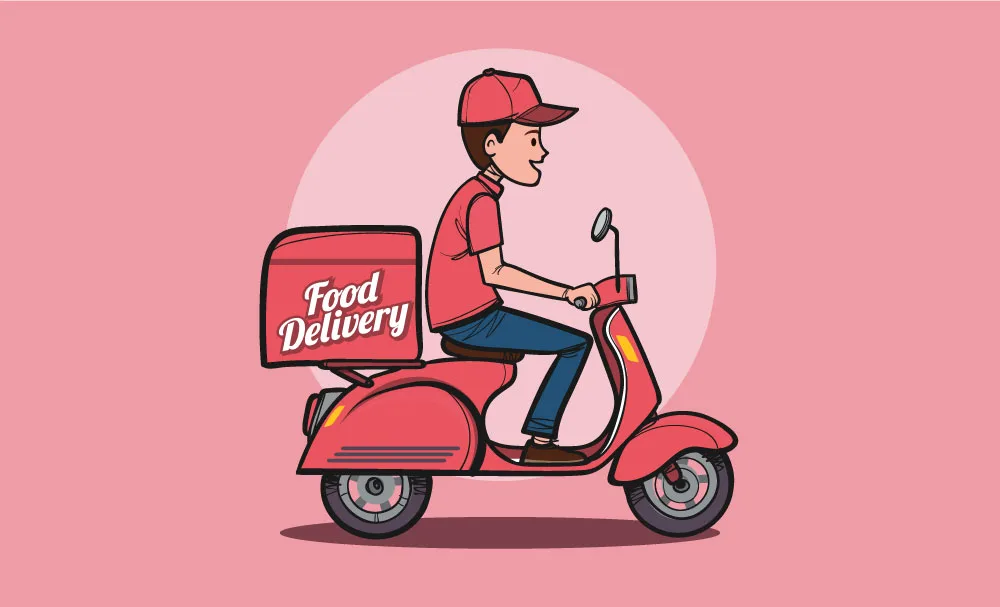Are you looking to make money through food delivery but unsure which platform is the most lucrative? This comprehensive guide will break down the top-performing services and provide valuable insights on how to maximize your earnings. With the rise of food delivery services, it can be overwhelming trying to figure out which one will yield the highest profits. Don’t waste time and effort on a platform that won’t bring in significant income. Let me help you avoid any mistakes or disappointments as you navigate your way through the food delivery world.
As someone who has personally tried various food delivery apps and researched extensively on their payment structures, I have gained valuable expertise on what truly generates substantial income. Trust me, I’ve been delivering for years and know all the tips and tricks to boost your earnings. This article is perfect for anyone interested in making money through food delivery, whether you’re a college student looking for a side hustle or a full-time worker wanting to supplement your income. No matter where you are in life, this guide will provide valuable information for maximizing your potential earnings. Imagine being able to earn extra cash while working flexible hours from the comfort of your own car. Sounds amazing, right? Well, it is! And I’m here to show you exactly how with my personal experiences and helpful advice. Let’s dive into this topic together and discover which food delivery service can help you make the most money!
So, what food delivery makes the most money?
The food delivery industry has exploded in recent years, with the rise of apps like UberEats, Grubhub, and DoorDash. These platforms have made it easier than ever for people to order food from their favorite restaurants and have it delivered right to their doorstep. But which food delivery service makes the most money?
The answer is not a simple one, as each platform operates differently and has its own unique business model. However, according to a report by Second Measure, DoorDash currently holds the top spot for market share among U.S. consumers at 45%, followed by Grubhub at 23% and UberEats at 22%. This means that DoorDash likely brings in the most revenue out of these three major players.
However, this does not necessarily mean that DoorDash drivers make more money than those working for other services. In fact, many factors can affect how much a driver earns per trip such as location, distance traveled, time spent waiting for orders or traffic conditions.
Other popular food delivery services include Postmates (9% market share), Caviar (1%), and Seamless (less than 1%). Some of these platforms may offer higher pay rates or bonuses to attract more drivers in certain areas.
In addition to base pay rates per trip or hour worked, some platforms also allow customers to tip their drivers through the app. This can significantly increase a driver’s earnings depending on customer generosity.
It is worth noting that while these numbers give us an idea of which platform might bring in the most overall revenue or market share, they do not take into account expenses such as gas and vehicle maintenance that drivers must cover themselves.
Ultimately, the amount of money a driver makes depends on various factors including location, demand, speed, and efficiency. However, it seems clear that being a driver for any major food delivery service can be profitable if done correctly. The key is finding ways to maximize your earnings through strategic planning and efficiency. Additionally, factors such as customer tips and bonuses can also make a significant difference in overall earnings.
In conclusion, while DoorDash may currently hold the top spot for market share among food delivery services, it is not necessarily the one that makes the most money for its drivers. Each platform has its own unique business model and various factors can affect a driver’s earnings. Ultimately, becoming a successful food delivery driver requires careful consideration of all these elements to maximize profits.
Understanding Different Food Delivery Platforms and Their Profitability
In today’s fast-paced world, food delivery platforms have become essential for many people. They connect hungry customers with local restaurants, making it easy to enjoy delicious meals from the comfort of home. Each platform has its unique features and ways to make money. For instance, platforms like Uber Eats and DoorDash charge restaurants a commission fee for every order they receive through the app. This means that while the restaurant benefits from increased sales, they also share a portion of their earnings with the delivery service. Additionally, these apps often provide promotional deals or discounts to attract new users, further driving up their overall profitability.
On the other hand, some platforms focus on subscription models like Grubhub+, which allows loyal customers to pay a monthly fee in exchange for free delivery on eligible orders. This encourages repeat business and fosters customer loyalty while providing steady income for both the restaurants and the delivery service itself. Moreover, each platform invests heavily in marketing strategies to outshine competitors; think flashy ads or partnerships with popular food brands that create buzz around certain offerings.
Ultimately, understanding how these different food delivery services operate can shed light on their complex relationship with profit margins within this evolving industry.
The Role of Location and Demand in Determining Earnings from Food Delivery
When it comes to food delivery, the location plays a crucial role in shaping how much a driver can earn. Areas bustling with restaurants and busy streets generally offer more opportunities for deliveries than quieter neighborhoods. For instance, if someone is working in a downtown area filled with popular eateries and offices, they are likely to receive orders more frequently. This high volume of demand not only means faster earnings but might also lead to tips that reflect the convenience they provide during lunch breaks or late-night cravings. On the other hand, if drivers operate in less populated regions where restaurants are sparse, their potential earnings could dwindle as they spend more time waiting for orders.
Moreover, demand fluctuates based on various factors such as time of day and local events. During lunch hours or weekend evenings when many people prefer dining at home instead of eating out, the need for delivery services peaks. Special occasions like holidays or sporting events can further amplify this demand, creating golden opportunities for drivers to increase their income through multiple deliveries within short periods. Understanding these patterns allows delivery drivers to strategize effectively—working during peak times and positioning themselves wisely can significantly enhance their overall earnings while navigating through different locations smoothly.
Read also: retrospective appraisal

Maximizing Profits: Tips to Increase Your Income on Any Food Delivery Platform
In today’s world, food delivery platforms have become a popular way to earn extra cash. To truly maximize profits on these services, it’s important to understand the nuances of how they operate. First, timing is everything. By delivering during peak hours—like lunch and dinner—you can tap into higher demand and make more per order. Additionally, getting familiar with local restaurants helps you pick up orders from those that offer better pay or bonuses for deliveries during specific times.
Another key tip involves staying organized and efficient. Consider creating a routing strategy that reduces drive time between pickups and drop-offs. This not only saves gas but also allows you to take on more orders in less time. Furthermore, engaging positively with customers can lead to better tips; polite communication goes a long way! You might even consider using apps designed for gig workers, which help track your earnings and expenses effectively.
Here are some simple strategies:
- Choose busy neighborhoods.
- Leverage promotions or incentives offered by the platform.
- Keep track of your vehicle’s maintenance for fuel efficiency.
By applying these tips regularly, anyone can see an increase in their income while enjoying the flexibility that food delivery offers!
Analyzing Payment Structures: How Do The Top Food Delivery Services Compare?
When it comes to food delivery services, understanding their payment structures can feel like navigating a maze. Each platform has its own way of charging customers, which often includes base fees, delivery charges, and tip options. For instance, DoorDash typically adds a small service fee on top of the delivery cost. This means that when you order your favorite pizza at $15 with a $5 delivery fee and a 10% service charge, you’d end up paying around $22 or more before tipping your driver. In contrast, Uber Eats combines both the base price of the food and an additional fee based on distance; this can make ordering feel slightly unpredictable depending on how far the restaurant is from your location.
Another essential factor to consider is how these platforms handle tips for drivers. Most services provide an option for users to choose either a default percentage or enter their desired amount during checkout. For example, with Grubhub, you have the flexibility to change this tip based on the quality of service you’ve received—especially if your food arrived earlier than expected! Overall, while all these platforms aim to deliver convenience right to our doorsteps, their distinct pricing methods play a significant role in shaping our overall experience as customers.
- A transparent breakdown helps build trust.
- Packed promotions can lure new users.
You may also like: financing options for joint ventures
Case Studies: Real-Life Examples of Earnings from Various Food Delivery Services
When it comes to understanding how much money one can earn from food delivery services, real-life examples offer valuable insights. Take Sarah, for instance, a college student who works with a popular delivery app. On busy weekend nights, she finds herself earning up to $30 an hour. This is mainly due to surge pricing and generous tips from hungry customers eager for late-night snacks. Sarah appreciates the flexibility of her schedule; she can choose when to work and still make enough to cover her expenses while enjoying the thrill of being out in the city.
Another example is Michael, who decided to become a full-time driver after losing his job during tough economic times. He shares that by working strategically—focusing on peak hours like lunch and dinner—he averages around $25 per hour after expenses. Additionally, he leverages multiple platforms simultaneously; this approach maximizes his earnings as he can switch between apps based on demand. Both Sarah and Michael showcase how gig economy jobs allow individuals not just financial independence but also personal freedom in their working hours.
As these stories unfold, they underline how adaptability plays a crucial role in making food delivery services financially rewarding.
Each person’s experience highlights unique strategies that lead them toward success in this bustling industry.

